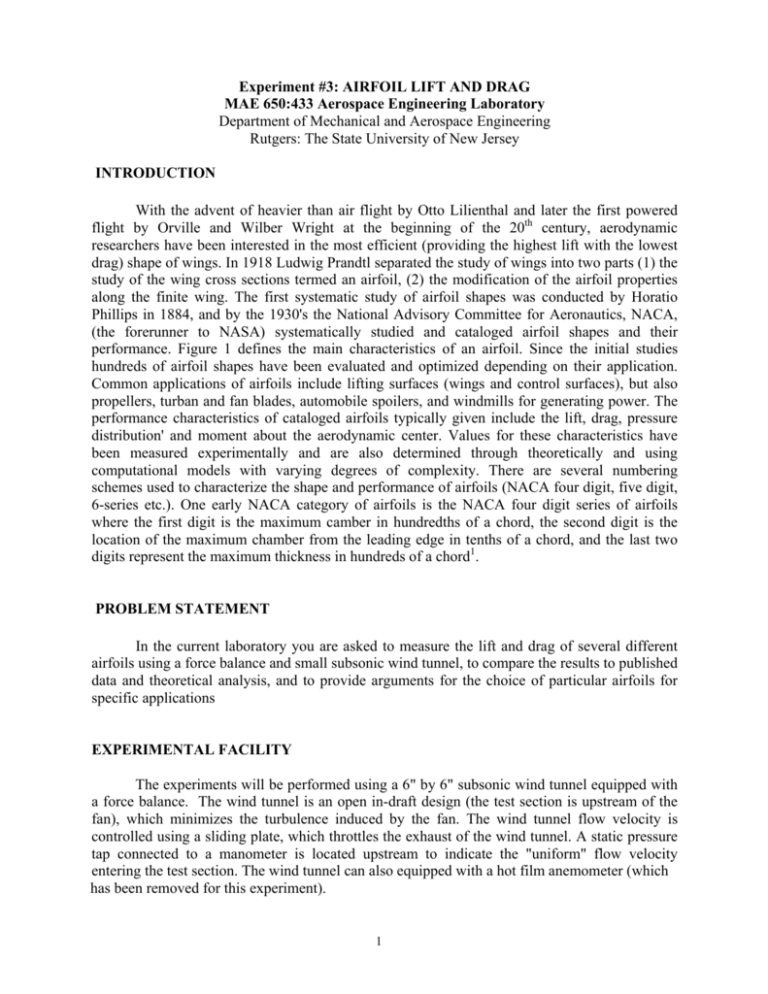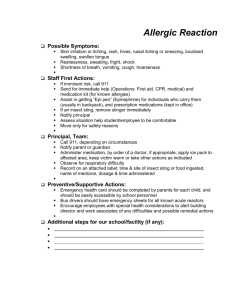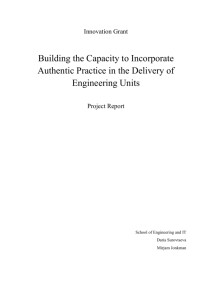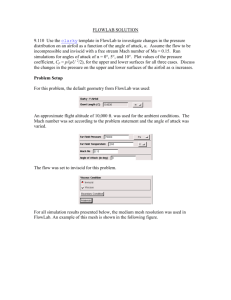Lab # 3 - Rutgers University School of Engineering
advertisement

Experiment #3: AIRFOIL LIFT AND DRAG MAE 650:433 Aerospace Engineering Laboratory Department of Mechanical and Aerospace Engineering Rutgers: The State University of New Jersey INTRODUCTION With the advent of heavier than air flight by Otto Lilienthal and later the first powered flight by Orville and Wilber Wright at the beginning of the 20th century, aerodynamic researchers have been interested in the most efficient (providing the highest lift with the lowest drag) shape of wings. In 1918 Ludwig Prandtl separated the study of wings into two parts (1) the study of the wing cross sections termed an airfoil, (2) the modification of the airfoil properties along the finite wing. The first systematic study of airfoil shapes was conducted by Horatio Phillips in 1884, and by the 1930's the National Advisory Committee for Aeronautics, NACA, (the forerunner to NASA) systematically studied and cataloged airfoil shapes and their performance. Figure 1 defines the main characteristics of an airfoil. Since the initial studies hundreds of airfoil shapes have been evaluated and optimized depending on their application. Common applications of airfoils include lifting surfaces (wings and control surfaces), but also propellers, turban and fan blades, automobile spoilers, and windmills for generating power. The performance characteristics of cataloged airfoils typically given include the lift, drag, pressure distribution' and moment about the aerodynamic center. Values for these characteristics have been measured experimentally and are also determined through theoretically and using computational models with varying degrees of complexity. There are several numbering schemes used to characterize the shape and performance of airfoils (NACA four digit, five digit, 6-series etc.). One early NACA category of airfoils is the NACA four digit series of airfoils where the first digit is the maximum camber in hundredths of a chord, the second digit is the location of the maximum chamber from the leading edge in tenths of a chord, and the last two digits represent the maximum thickness in hundreds of a chord1. PROBLEM STATEMENT In the current laboratory you are asked to measure the lift and drag of several different airfoils using a force balance and small subsonic wind tunnel, to compare the results to published data and theoretical analysis, and to provide arguments for the choice of particular airfoils for specific applications EXPERIMENTAL FACILITY The experiments will be performed using a 6" by 6" subsonic wind tunnel equipped with a force balance. The wind tunnel is an open in-draft design (the test section is upstream of the fan), which minimizes the turbulence induced by the fan. The wind tunnel flow velocity is controlled using a sliding plate, which throttles the exhaust of the wind tunnel. A static pressure tap connected to a manometer is located upstream to indicate the "uniform" flow velocity entering the test section. The wind tunnel can also equipped with a hot film anemometer (which has been removed for this experiment). 1 A force balance (fig. 2) is used by researchers to measure the reaction forces and moments on a model and allows the orientation (angle of attack, pitch, yaw) to be changed during a test. Complex force balances in large-scale facilities can measure all thee forces and all three moments on the model simultaneously. The force balance in this experiment will be used to measure only the axial and normal force relative to the rotation sting as shown in fig. 2. Using the axial and normal force, and the rotation sting angle θ, the lift and drag can be computed using the relationship shown in fig. 2. The forces are measured using the load cell, which is the hollow rectangular device at the end of the sting. The rotation sting is connected to a shaft equipped with an indexed rotation stage allowing the angle of attack to be varied throughout the test. Since the rotation stage is stiff only use the side arm located on the stage on the outside of the tunnel to rotate the model, DO NOT ROTATE THE STAGE USING THE STING OR THE AIRFOIL SINCE THEY WILL BREAK. When the thumbscrew on the rotation stage is loosened, the stage can be rotated coarsely and then when tightened a rotation angle micrometer fine can be used for a fine adjustment. DO NOT OVER TIGHTEN THE THUMB SCREW SINCE YOU MAY DAMAGE THE ROTATION STAGE. The load cell uses strain gage circuits whose voltage output is calibrated to read the force in grams. A two-channel oscilloscope monitors the load cell bridge outputs and performs averaging of the signals, which fluctuate because of turbulence. Four finite wings with three different airfoil types, shown in fig. 3, will be used for this experiment. PLEASE BE VERY CAREFUL WHEN HANDLING THESE WINGS SINCE THEY ARE EXTREMELY FRAGILE AND SMALL DENTS AND SCRATCHES CAN EFFECT THE RESULTS (POINTS WILL BE DEDUCTED FROM THE LAB GROUP FOR DAMAGE TO AIRFOILS). Airfoils AR l and AR2 are symmetric NACA 0012 airfoils with two different aspect ratios of 3.96 and 2.05 respectively. Airfoils AR3 and AR4 are NACA 4412 chambered airfoils with and without flaps with the same aspect ratio as AF2. The airfoils are attached to the load cell using a mounting sting, which is bent so that the airfoils are oriented at a slight angle of attack when the rotation sting is at zero degrees. This offset mounting sting angle is needed to provide the needed large airfoil angles of attack during experimentation, since the force balance has a limited range of ± 12°. The offset angles, θο, are shown for each airfoil in fig. 3 so that the actual angle of attack can be calculated for each rotation sting angle, θ. EXPERIMENTAL PROCEDURE Turn the power on to the force balance, which is located on the side of the existing digital bridge readout, immediately when you arrive and let the unit warm up for approximately 10 minutes before making measurements. Note that the digital bridge readout cannot provide averaging of the fluctuating bridge signals and will not be used for this experiment. Oscilloscope Setup Channel 1 should be wired to the output of the axial force sensor and Channel 2 should be wired to the output of the normal force sensor located on the back of the load cell display. The display should appear as in Figure 4. Note the waveforms and use the average voltage measurements [Vavg(I) and Vavg(2)] shown at the bottom of the screen. The load cell has been calibrated so that the voltage output is 1 mV/gram. Following are the settings, which should be used for this experiment, as well as a description of how to change them: 2 Time Scale: 500 ms/ Use knob labeled Time/Div in the HORIZONTAL controls group Time Scale Delay: 0.00 s Use knob labeled Delay in the HORIZONTAL controls group Activate Channel 1 and set to DC coupling Press the 1 button in the VERTICAL controls group above the channel 1 input BNC. When the selections appear at the bottom of the screen press the button under the 1 until On is highlighted and then press the button under Coupling until DC is highlighted. Activate Channel 2 and set to DC coupling Press the 2 button in the VERTICAL controls group above the channel 2 input BNC. When the selections appear at the bottom of the screen press the button under the 1 until On is highlighted and press the button under Coupling until DC is highlighted. Channel 1 voltage scale: 100 mV Use knob labeled Volts/div in the VERTICAL controls group above the channel 1 input BNC. Channel 2 voltage scale: 100 mV Use knob labeled Volts/div in the VERTICAL controls group above the channel 2 input BNC, Channel 1 voltage offset: 100.0 mV Use knob labeled Position in the VERTICAL controls group above the channel 1 input BNC. Channel 2 voltage offset: -100.0 mV Use knob labeled Position in the VERTICAL controls group above the channel 1 input BNC. Trigger Source: Channel 1 Press the [Source] button under the TRIGGER controls group. When the selections appear at the bottom of the screen press the button under the 1. Trigger Mode: Auto Press the [Mode] button under the TRIGGER controls group. When the selections appear at the bottom of the screen press the button under Auto. Display Average Voltage of Channel 1: Vavg(l) = * * * *. * * mV Press the [Voltage] button under the Measure controls group. When the selections appear at the bottom of the screen press the button under Source until 1 is highlighted and press the button under Vavg from the Voltage Measurements group. Display Average Voltage of Channel 2: Vavg(2) = * * * *. * * mV Press the [Voltage] button under the Measure controls group. When the selections appear at the bottom of the screen press the button under Source until 2 is highlighted and press the button under Vavg from the Voltage Measurements group. Normal Display Press the [Display] button. When the display mode selections appear at the bottom of the screen press the button under Normal. Zeroing of the Sting Angle and Force Balance First the rotation stage must be zeroed relative to the free stream direction. To accomplish this with the load cell empty, rotate the sting so that the mounting hole on the load cell is 3 " above the floor of the wind tunnel (use ruler). Record this angle and make all measurements relative to this angle. 3 Next the load balance must be zeroed. To do this turn the Time/Div knob on the oscilloscope under the HORIZONTAL controls group until the time scale on the scope is 1ms per division (this will update the average voltage measurement more quickly on the scope). Now using the zeroing knob on the Normal and Axial force balance controller, turn the knob until the average voltage displayed on the scope is within ± 10.0 mV of zero. After zeroing the balance it will not be necessary to adjust the zero again since a measurement is taken with the flow for each angle of attack position. Reset the horizontal scale on the oscilloscope to 500.0 ms per division. Setting the Force Balance Mounting Sting Offset In general when using a force balance in wind tunnels the researcher would like to measure only the forces and moments due to the model and neglect the effects of the mounting hardware and sting which attach the model to the balance. Unfortunately this can be difficult since the effect of the mounting sting is influenced by the presence of the model. Therefore, it is customary to use a calibration mounting sting similar to that used on the airfoils, run the tunnel with only the mounting sting attached, and record the forces for different angles of attack. Since the load cell is located at the end of the sting the only effect in the present system is due to the shape of the load cell itself and the small mounting sting. 1. Attach the small calibration mounting sting (the angled cylinder with no airfoil attached) onto the force balance and slightly tighten the setscrew. Make sure the calibration sting is oriented at a positive angle of attack when the rotation sting angle (θ) is at zero degrees. 2. With the wind tunnel off zero the wind tunnel speed manometer using the adjustment screw. 3. Turn the wind tunnel on but close the flow control plate so there is no flow in the wind tunnel. 4. Starting with a rotation sting angle of θ = -18˚ record the average voltage from the oscilloscope for the axial and normal forces in 2˚ increments up to a sting angle of θ = + 18˚. Since the load cell bridge circuitry can drift in time, each measurements should include voltage readings. To accomplish this, keeping the wind tunnel on for each sting position, first record the voltages with the control plate fully closed (so that there is no flow in the wind tunnel) and a then with the control plate fully open (so that tunnel is at maximum velocity). For each position, record the sting angle, wind tunnel air velocity, and axial and normal force with the control plate closed and opened. Note that the load cell is calibrated to grams, which needs conversion Newtons (Oscilloscope output Æ 1 mV/gram, 1 gram * 9.81 m/s2 / 1000 = 1N). Airfoil Axial and Normal Force Measurements Four airfoils will be tested using the following procedure for each one. 1. Attach the airfoil to the force balance without tightening the mounting setscrew. Make sure the airfoil is oriented at a positive angle of attack when the rotation sting angle (θ) is at zero degrees. To ensure that the airfoil is parallel to the wind tunnel floor increase the sting angle until the leading edge of the airfoil is almost touching the ceiling of the wind tunnel. With the mounting sting lose in the load cell, rotate the airfoil until the leading edge of both wing tips are parallel to the ceiling of the wind tunnel. Slightly tighten the setscrew to secure the airfoil to the sting. 4 DO NOT PUT FORCE ON THE AIRFOIL TO ADJUST ANGLE SINCE IT IS FRAGILE TURN THE ROTATION STAGE USING THE EXTERNAL HANDLE TO ADJUST THE ANGLE OF ATTACK. 2. Turn on the wind tunnel. 3. Starting at a minimum rotation sting angle (make it a multiple of 2˚) record the axial and normal forces in 2˚ increments to the maximum sting angle. The minimum sting angle is determined when the load cell is not resting on the floor, or when the leading edge of the wing is located about 20 mm above the wind tunnel floor (the boundary layer on the wind tunnel floor may effect the force measurements). The maximum sting angle is determined when the leading edge of the wing is about 20 mm below the wind tunnel ceiling. For each position record the sting angle, wind tunnel air velocity from the manometer, and the axial and normal forces. For each angle record the bridge outputs first with the flow control plate completely closed and a second time with the control plate completely open. 4. Turn off wind tunnel. Remove current model and proceed to next airfoil. Repeat steps 1-3. ITEMS TO BE INCLUDED IN THE REPORT 1. Define the following terms associated with airfoils: a. Lift b. Drag c. Profile Drag d. Induced Drag e. Lift slope f. Stall g. Flow separation h. Kutta condition 2. From the components of the force measurements show that the lift and drag are given by: D = A cos(θ) + N sin(θ) and L = N cos(θ) − Α sin(θ) where: L = lift force D = drag force A = sting axial force N = sting normal force θ = sting angle 3. Tabulate the sting angle, angle of attack, lift force (L) in Newtons, the drag force (D) in Newtons, the lift coefficient (CL), and the drag coefficient (CD). Also calculate the Reynolds (Re) number for each airfoil. These are given by: CL = L/q∞S CD = D/ q∞S Re = V∞c/ν q∞= ρ∞ V∞2/2 V∞ is the free stream velocity, S is the plan form area (cord time width) c is the cord length and ν is the kinematic viscosity. 5 Note that the mounting sting of the airfoils is at an offset angle not aligned along the imaginary line from the airfoil leading to trailing edges. Using the sting offset angles in fig. 3 the actual angle of attack of the airfoils should be calculated from the rotation sting angle (θ) and the sting offset angle θο. Also when calculating the lift and drag, the tunnel off and calibration mounting sting data should be subtracted from the measurements. 4. Plot three graphs: lift coefficient versus angle of attack, drag coefficient versus angle of attack, and the drag polar (CL versus CD on the x-axis). In each graph show the results for all the airfoils. Also plot the theoretical lift thin airfoil theory lift coefficient for a symmetric airfoil which is given from thin airfoil theory as CL = 2πα. 5. Discuss the differences you observe in the profiles between the airfoils and give the reasons for the differences when possible. Why do the lift and drag plots have the trends they do (i.e. what is occurring in the flow field around the airfoil causing the plot to have the shape it does? Refer to Figure 5 of this handout). 6. Discuss the similarities and differences in the curves obtained from the experiment and the attached plots from reference 2. Give possible reasons for the differences (note that the differences are not entirely due to experimental errors). What is the difference between section drag and the drag measured in this experiment? 7. If you were asked to select an airfoil for a model aircraft with a chord length of 0.2 m and a velocity of 5 m/s would it be better to use the published data given or measured data from this experiment (give an explanation for you answer). From your data, state which airfoil you would use and discuss the reasons why you selected the airfoil for the following applications. a. aircraft at cruise conditions b. aircraft landing c. racing car spoiler where the rules state that the airfoil must be at zero angle of attack Be sure to give sample calculations for the above analysis and discuss the accuracy of the results. REFERENCES 1. Ira H. Abbott and Albert E. Von Doenhoff, "Theory of Wing Sections", Dover Publishing, New York, 1951. 6 7 8 9 10 11







